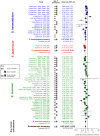The relationship between water, sanitation and schistosomiasis: a systematic review and meta-analysis
- PMID: 25474705
- PMCID: PMC4256273
- DOI: 10.1371/journal.pntd.0003296
The relationship between water, sanitation and schistosomiasis: a systematic review and meta-analysis
Abstract
Background: Access to "safe" water and "adequate" sanitation are emphasized as important measures for schistosomiasis control. Indeed, the schistosomes' lifecycles suggest that their transmission may be reduced through safe water and adequate sanitation. However, the evidence has not previously been compiled in a systematic review.
Methodology: We carried out a systematic review and meta-analysis of studies reporting schistosome infection rates in people who do or do not have access to safe water and adequate sanitation. PubMed, Web of Science, Embase, and the Cochrane Library were searched from inception to 31 December 2013, without restrictions on year of publication or language. Studies' titles and abstracts were screened by two independent assessors. Papers deemed of interest were read in full and appropriate studies included in the meta-analysis. Publication bias was assessed through the visual inspection of funnel plots and through Egger's test. Heterogeneity of datasets within the meta-analysis was quantified using Higgins' I2.
Principal findings: Safe water supplies were associated with significantly lower odds of schistosomiasis (odds ratio (OR) = 0.53, 95% confidence interval (CI): 0.47-0.61). Adequate sanitation was associated with lower odds of Schistosoma mansoni, (OR = 0.59, 95% CI: 0.47-0.73) and Schistosoma haematobium (OR = 0.69, 95% CI: 0.57-0.84). Included studies were mainly cross-sectional and quality was largely poor.
Conclusions/significance: Our systematic review and meta-analysis suggests that increasing access to safe water and adequate sanitation are important measures to reduce the odds of schistosome infection. However, most of the studies were observational and quality was poor. Hence, there is a pressing need for adequately powered cluster randomized trials comparing schistosome infection risk with access to safe water and adequate sanitation, more studies which rigorously define water and sanitation, and new research on the relationships between water, sanitation, hygiene, human behavior, and schistosome transmission.
Conflict of interest statement
The authors have declared that no competing interests exist.
Figures




References
-
- Steinmann P, Keiser J, Bos R, Tanner M, Utzinger J (2006) Schistosomiasis and water resources development: systematic review, meta-analysis, and estimates of people at risk. Lancet Infect Dis 6: 411–425. - PubMed
-
- Gryseels B, Polman K, Clerinx J, Kestens L (2006) Human schistosomiasis. Lancet 368: 1106–1118. - PubMed
-
- Rollinson D (2009) A wake up call for urinary schistosomiasis: reconciling research effort with public health importance. Parasitology 136: 1593–1610. - PubMed
Publication types
MeSH terms
Grants and funding
LinkOut - more resources
Full Text Sources
Other Literature Sources

